

Example #5 - Shipping Computer Monitors
Guacuco Computers, Inc.* will start shipping their brand-new Shell-shaped 15" monitor to their wide range of customers throughout the world. Given the intense competition in the computer monitor industry, Guacuco figures that they could try to save some shipping costs by optimizing their pallets throughout the various warehouses by where the product travels. The monitors are built somewhere in East Asia where the maximum allowable height is 1.45 meters (57 inches) including the pallet, they are stored in the Americas warehouse where the maximum height is 2.20 meters (87 inches) and in the European warehouse where the maximum height is 1.20 meters (47 inches).
The following describes how Quick Pallet Maker can find the box that will save shipping costs (by allowing more boxes per pallet) on different allowable pallet heights. The Operating System for this example uses commas (,) to separate decimals (although this can be changed in the "Numbers" Control Panel).
Input Data
- Package Shape: Rectangular (monitor) - select Rectangle from the Pull-Down menu.
- Units: cm - Select cm/kg from the Tools menu
- Monitor Length: 41 cm - type "41"
- Monitor Width: 37 cm - type "37"
- Monitor Height: 37 cm - type"37"
- In this case, Only the height and length are allowed to be vertical to protect the monitor innards during transportation.
- Monitor Weight: 10 kg. - type "10"
- Case Count: 1 - type "1"
- Board Thickness: 275-350# C Flute - Select from the Pull-Down menu and the values will update automatically.
- Construction: RSC-Regular Slotted Container - default
- Partitions: Square Liner - Choose Square Liner and Input a width and length addition of 1 cm, which would simulate a minimum styrofoam padding of 0,5 cm per side.
- Minimum and maximum case dimensions: Use default values
- Minimum and maximum case ratios: Use default values
- Shipping Pallet Dimensions: CHEP 120x100x14,5 cm - select CHEP 1200x1000 from the Pull-Down menu.
- Default values for the rest of the load restrictions.
- Maximum Load Weight: 1500 kg (1,5 Metric Tons), which is approximately the maximum weight a Forklift truck can carry. - Default value
The input window should look something like this. Note that commas (,) separate the decimals.
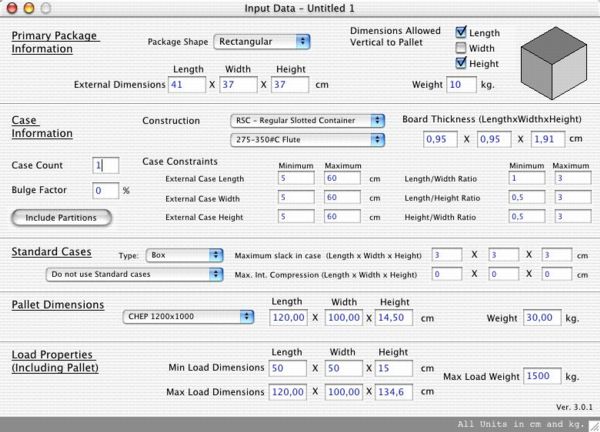
The dividers window will look like this:
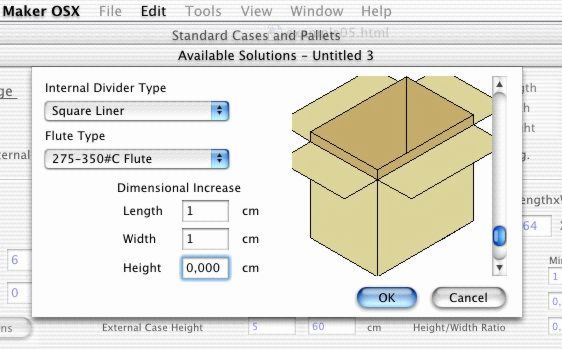
Given that the Maximum Pallet Height is variable, the user selects the Advanced Input Options from the Tools menu or presses the Ctrl+Alt+I (Command+Option+I for the Mac OS) keyboard shortcut. Once the data is filled in, the Advanced Input window should look like this:
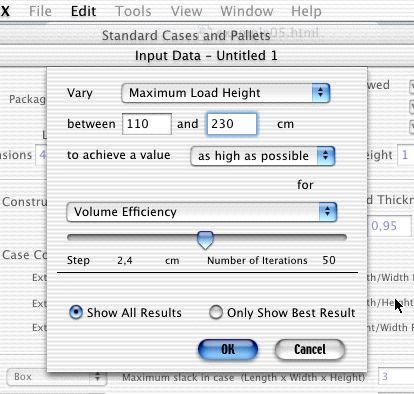
The user will vary the Maximum Load Height between 110 cm (slightly less than European warehouse) and 230 cm (slightly more than Americas warehouse) and will look for the highest possible value for cases per pallet. If the user would have chosen to view only one result (instead of the whole list), then Quick Pallet Maker would have displayed the pallet for the maximum height only (220 cm). The number of iterations was 50 but a higher value could have been used by pushing the slider to the rightmost position. The criteria for number of iterations depends mostly on the computer speed; the faster the speed, the more amount of iterations (and a smaller step) can be made in the same time. In essence, if you have a top-of-the-line computer, don't doubt on going full steam ahead.
Results
Once the OK button is pressed, the iteration window will appear and once the program's done iterating, the user will be presented with a solutions window that should look like this.
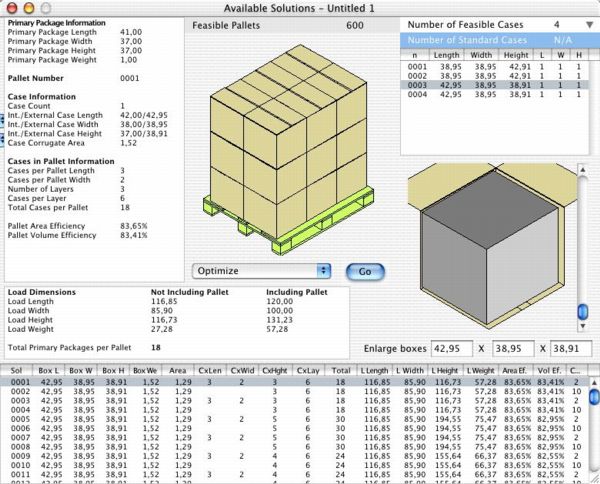
What Quick Pallet Maker did was to create 4 boxes by turning the monitor around within the box. The program calculated the amount of cases that would fit within each of the the Pallet Height limitations and copied the results onto the table above. The results were automatically sorted by the selected criteria of Volume efficiency so the best results are on the top of the list. However, we find out that we have more than 600 solutions that are hard to work with. Therefore, there are some considerations that can be made.
- The purpose of this exercise is to generate one box size that can be fit efficiently across different allowable pallet heights. Since the box that orients the monitors upwards provides the most efficiency, we should allow only the Primary Package height to be vertical (i.e. standing up).
- Since we already know that the best load orientations have a length greater than 110 cm and a width greater than 85 cm, we add these constraints in order to reduce clutter.
- Given that we are speeding up the iteration time by performing the actions mentioned above, we can increase the number of iterations that are executed in order to increase the precision of the pallet load heights and maybe find a solution that was blocked previously.
The modified input window should look like the graphic below.
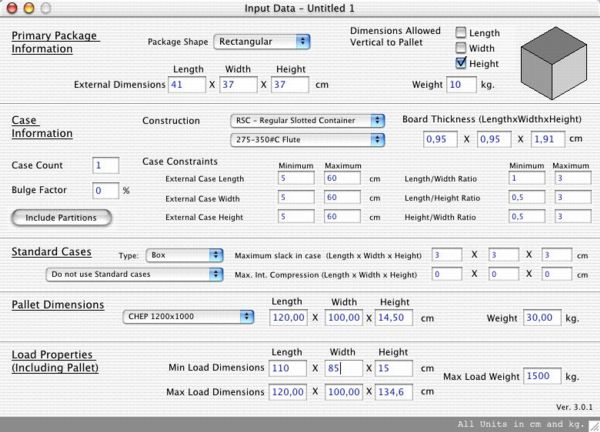
After running the iterations again, we will obtain a new set of pallets that can be ordered by height and then by area efficiency. Note that all the loads have the same length and width but different heights. This makes it much easier to remove layers in order to fit different allowable heights. We could have just run the calculations using a fixed maximum allowable height but it would not have shown us that there are only 4 different layer variants between the minimum and maximum height values. From these 4 solutions, we choose three that are the most suitable for the three different warehouses that we will accomodate to. The next thing to do would be to generate drawings for each one of the different allowable pallet heights (120 cm, 145 cm and 220 cm). The three drawings would look like this.
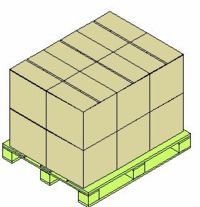 |
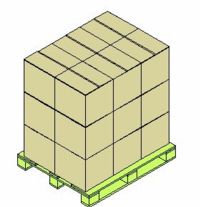 |
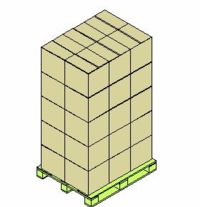 |
| European Warehouse Pallet (max. height = 120 cm) | Asian Warehouse Pallet (max. height = 145 cm) | Americas Warehouse Pallet (max. height = 220 cm) |
The packaging designer can generate three different reports to send to the Guacuco Computers Inc. warehouses around the world for palletizing instructions. These reports would be ready for exporting to a graphics file format or for printing.
* Imaginary Name

|

|
|

|